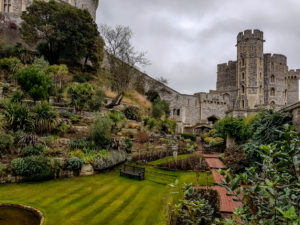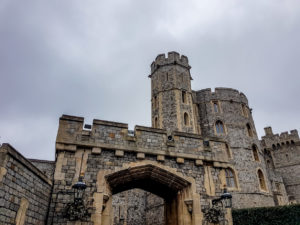 The original castle was built in the 11th century after the Norman invasion of England by William the Conqueror. Since the time of Henry I, it has been used by the reigning monarch and is the longest-occupied palace in Europe. The castle’s lavish early 19th-century State Apartments were described by early 20th-century art historian Hugh Roberts as “a superb and unrivaled sequence of rooms widely regarded as the finest and most complete expression of later Georgian taste”. Inside the castle walls is the 15th-century St George’s Chapel, considered by the historian John Martin Robinson to be “one of the supreme achievements of English Perpendicular Gothic” design.
The original castle was built in the 11th century after the Norman invasion of England by William the Conqueror. Since the time of Henry I, it has been used by the reigning monarch and is the longest-occupied palace in Europe. The castle’s lavish early 19th-century State Apartments were described by early 20th-century art historian Hugh Roberts as “a superb and unrivaled sequence of rooms widely regarded as the finest and most complete expression of later Georgian taste”. Inside the castle walls is the 15th-century St George’s Chapel, considered by the historian John Martin Robinson to be “one of the supreme achievements of English Perpendicular Gothic” design.
Originally designed to protect Norman dominance around the outskirts of London and oversee a strategically important part of the River Thames, Windsor Castle was built as a motte-and-bailey, with three wards surrounding a central mound. Gradually replaced with stone fortifications, the castle withstood a prolonged siege during the First Barons’ War at the start of the 13th century. Henry III built a luxurious royal palace within the castle during the middle of the century, and Edward III went further, rebuilding the palace to make an even grander set of buildings in what would become “the most expensive secular building project of the entire Middle Ages in England”. Edward’s core design lasted through the Tudor period, during which Henry VIII and Elizabeth I made increasing use of the castle as a royal court and center for diplomatic entertainment.
13th century
King John undertook some building works at Windsor, but primarily to the accommodation rather than the defenses. The castle played a role during the revolt of the English barons: the castle was besieged in 1214, and John used the castle as his base during the negotiations before the signing of the Magna Carta at nearby Runnymede in 1215. In 1216 the castle was besieged again by baronial and French troops under the command of the Count of Nevers, but John’s constable, Engelard de Cigogné, successfully defended it.
 The damage done to the castle during the second siege was immediately repaired in 1216 and 1221 by Cigogne on behalf of John’s successor Henry III, who further strengthened the defenses. The walls of the Lower Ward were rebuilt in stone, complete with a gatehouse in the location of the future Henry VIII Gate, between 1224 and 1230. Three new towers, the Curfew, Garter, and the Salisbury towers, were constructed. The Middle Ward was heavily reinforced with a southern stone wall, protected by the new Edward III and Henry III towers at each end.
The damage done to the castle during the second siege was immediately repaired in 1216 and 1221 by Cigogne on behalf of John’s successor Henry III, who further strengthened the defenses. The walls of the Lower Ward were rebuilt in stone, complete with a gatehouse in the location of the future Henry VIII Gate, between 1224 and 1230. Three new towers, the Curfew, Garter, and the Salisbury towers, were constructed. The Middle Ward was heavily reinforced with a southern stone wall, protected by the new Edward III and Henry III towers at each end.
Windsor Castle was one of Henry’s three favorite residences and he invested heavily in the royal accommodation, spending more money at Windsor than in any other of his properties. Following his marriage to Eleanor of Provence, Henry built a luxurious palace in 1240–63, based around a court along the north side of the Upper Ward. This was intended primarily for the queen and Henry’s children. In the Lower Ward, the king ordered the construction of a range of buildings for his own use along the south wall, including a 70 ft long chapel, later called the Lady Chapel. This was the grandest of the numerous chapels built for his own use, and comparable to the Sainte-Chapelle in Paris in size and quality.







